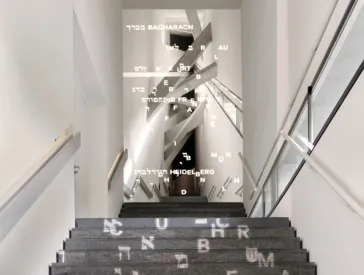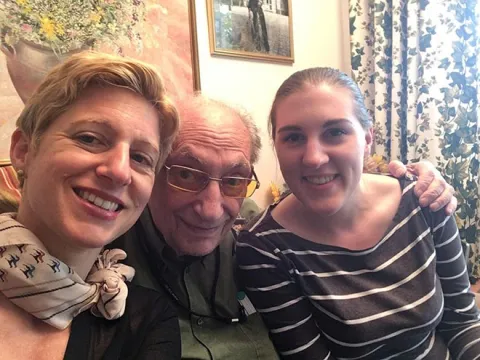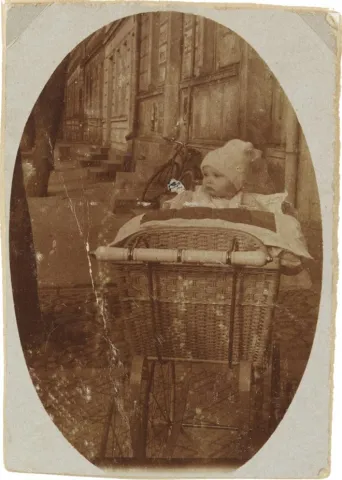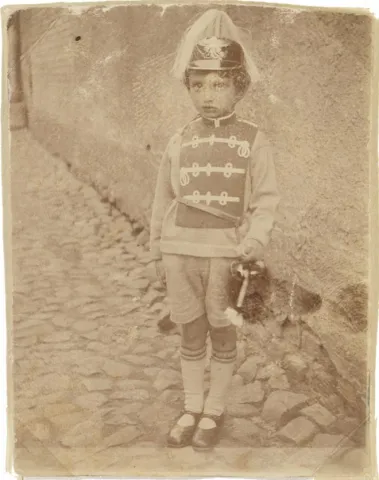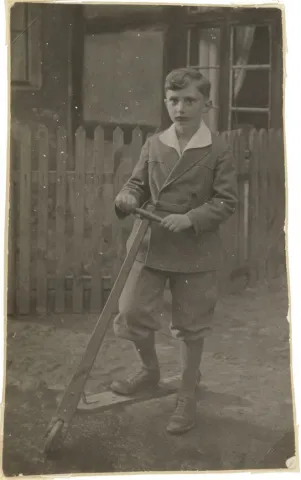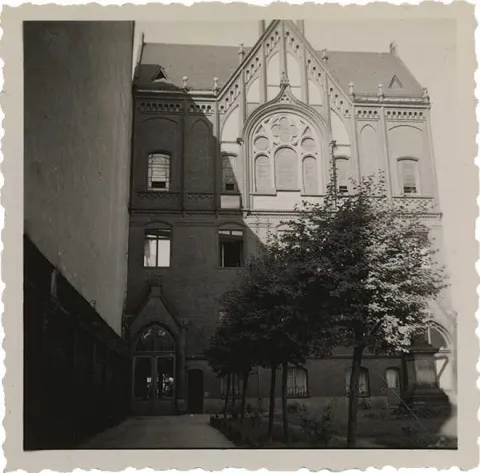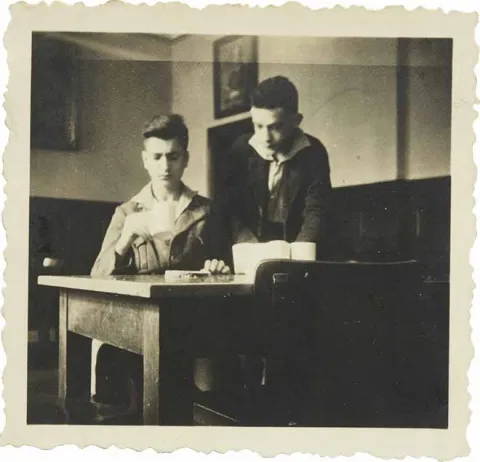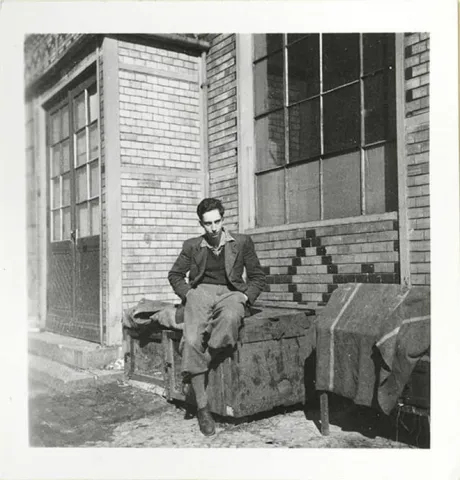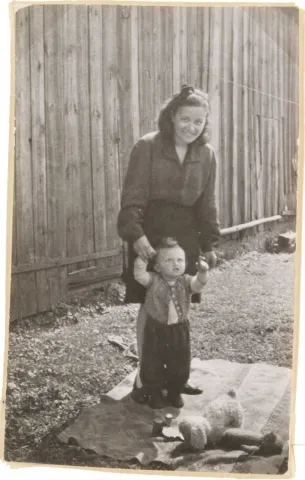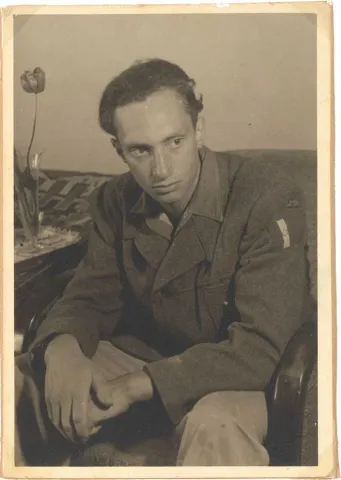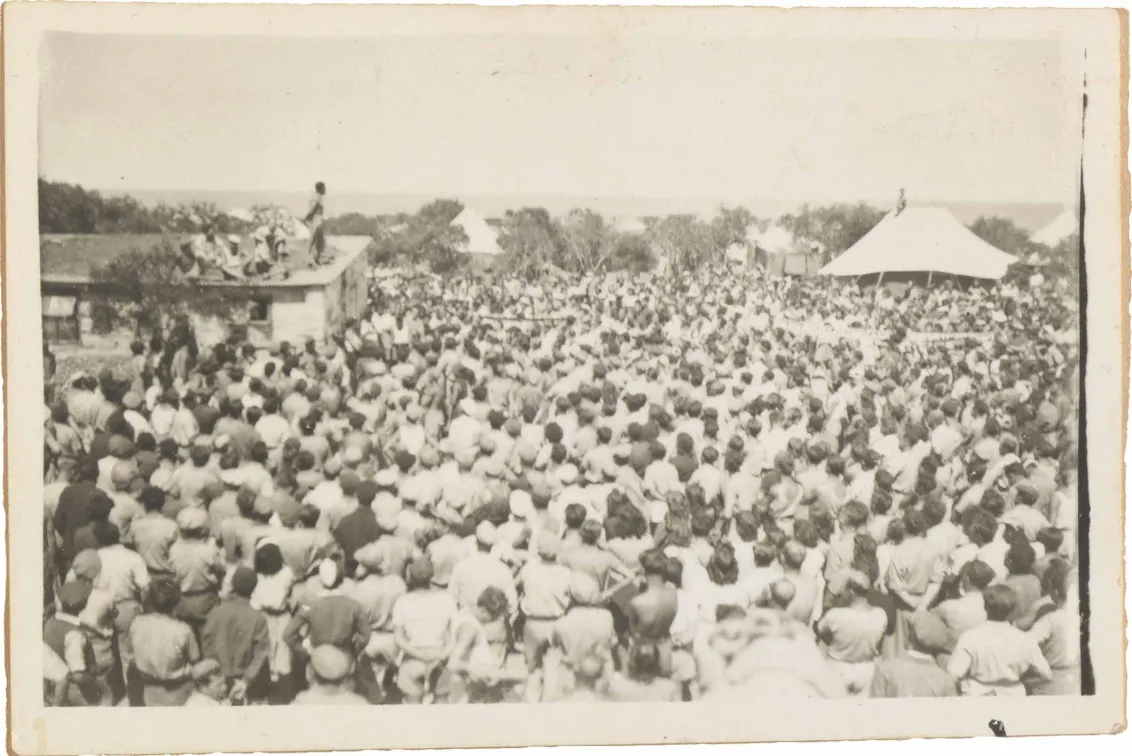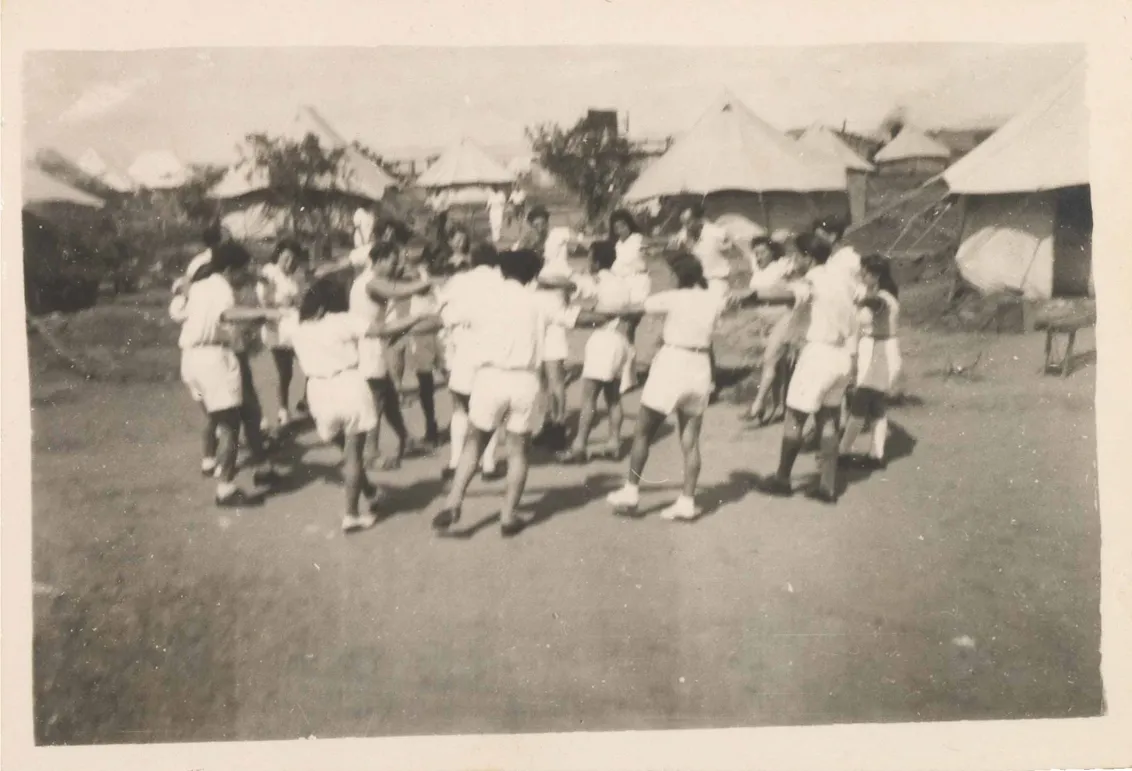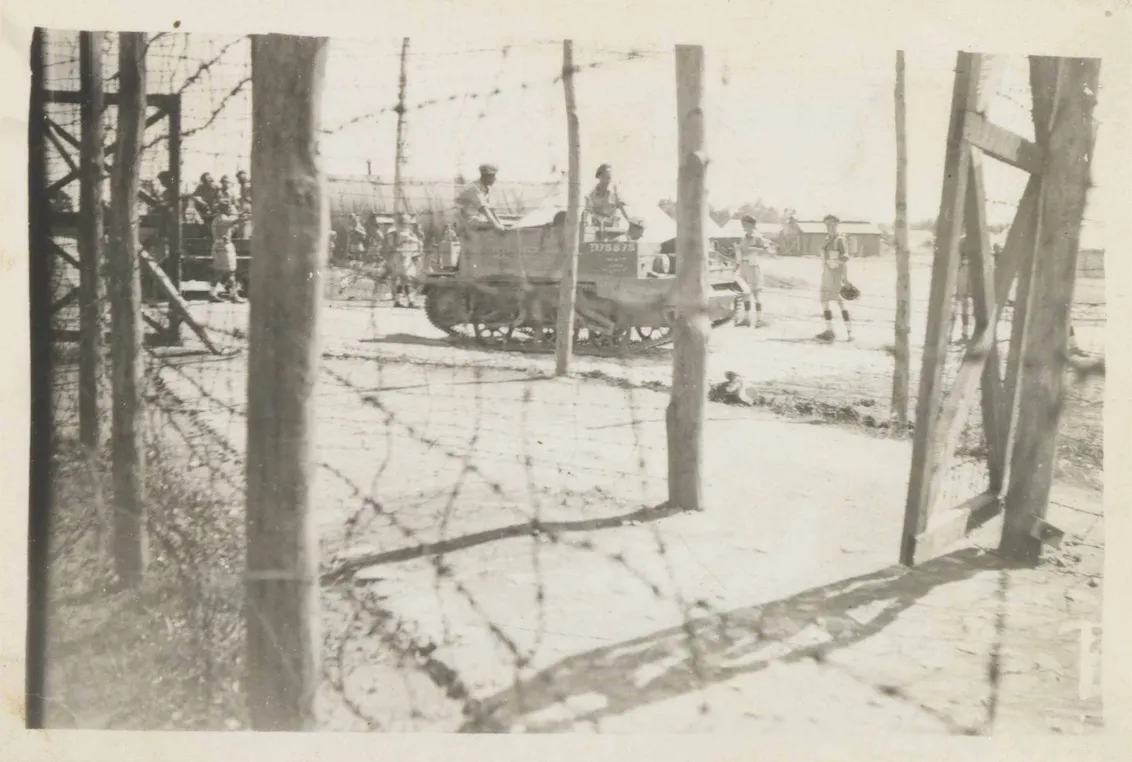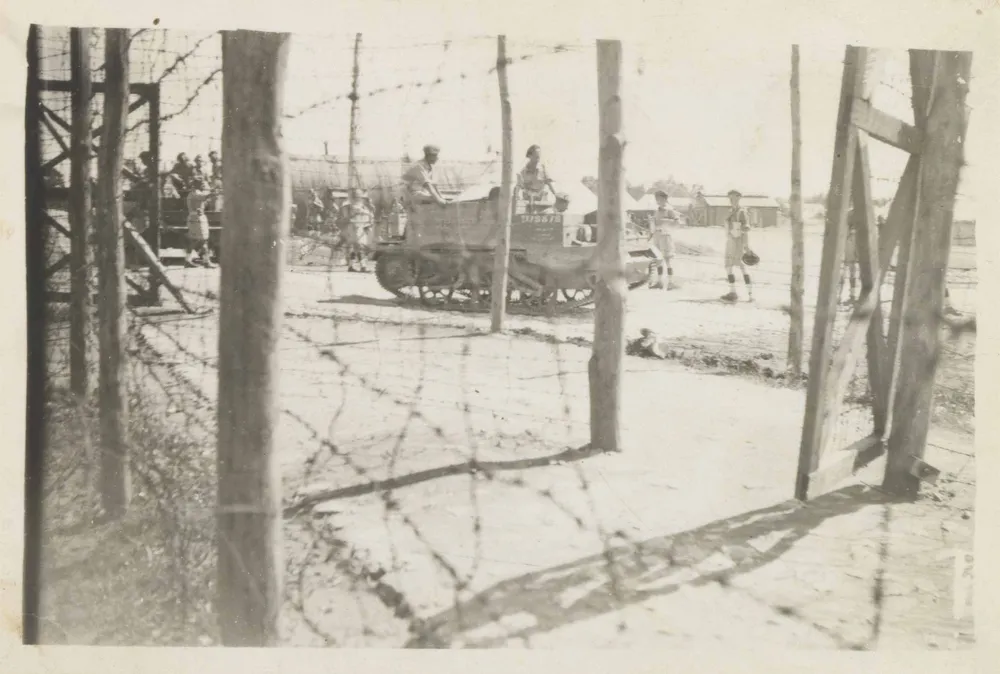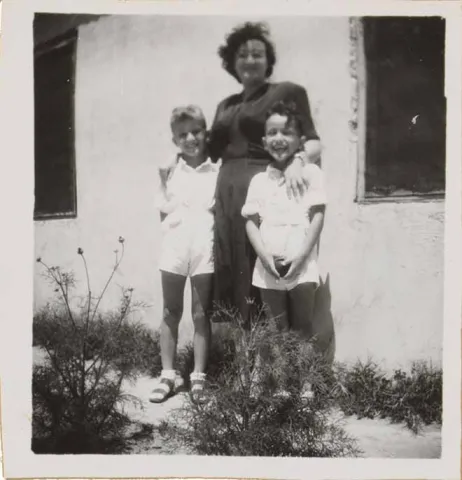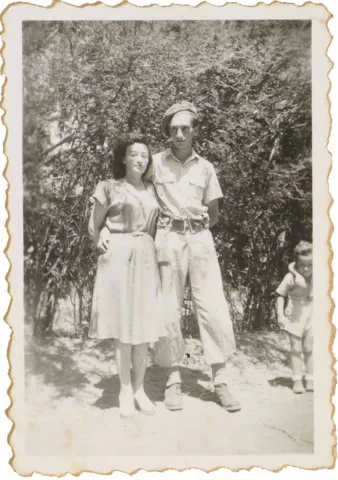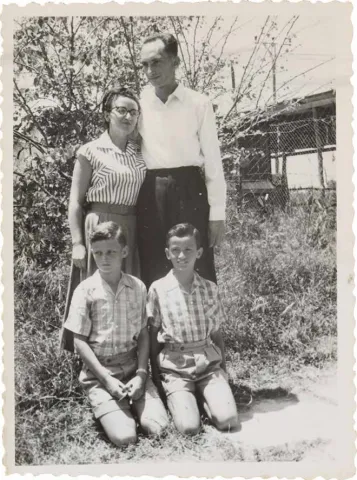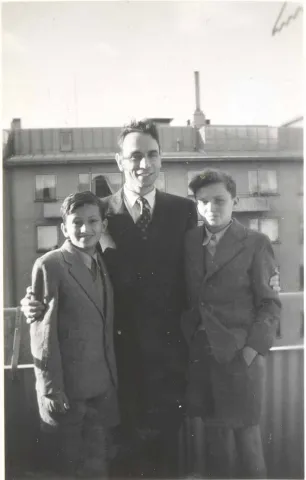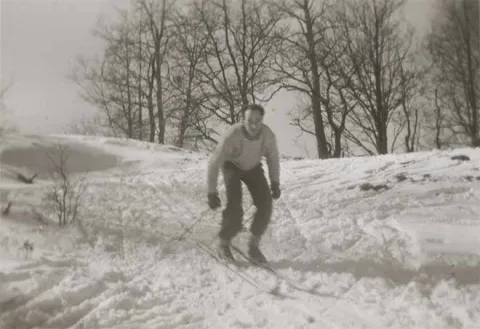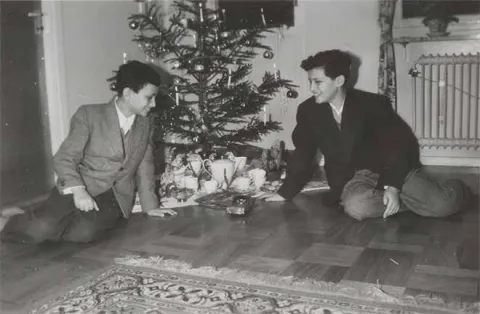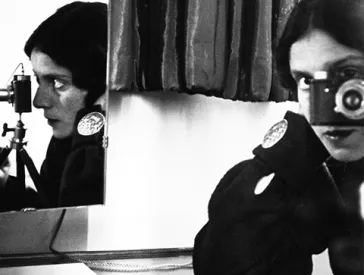Memories from the Life of Walter Frankenstein
With Many Photographs from the Walter and Leonie Frankenstein Collection
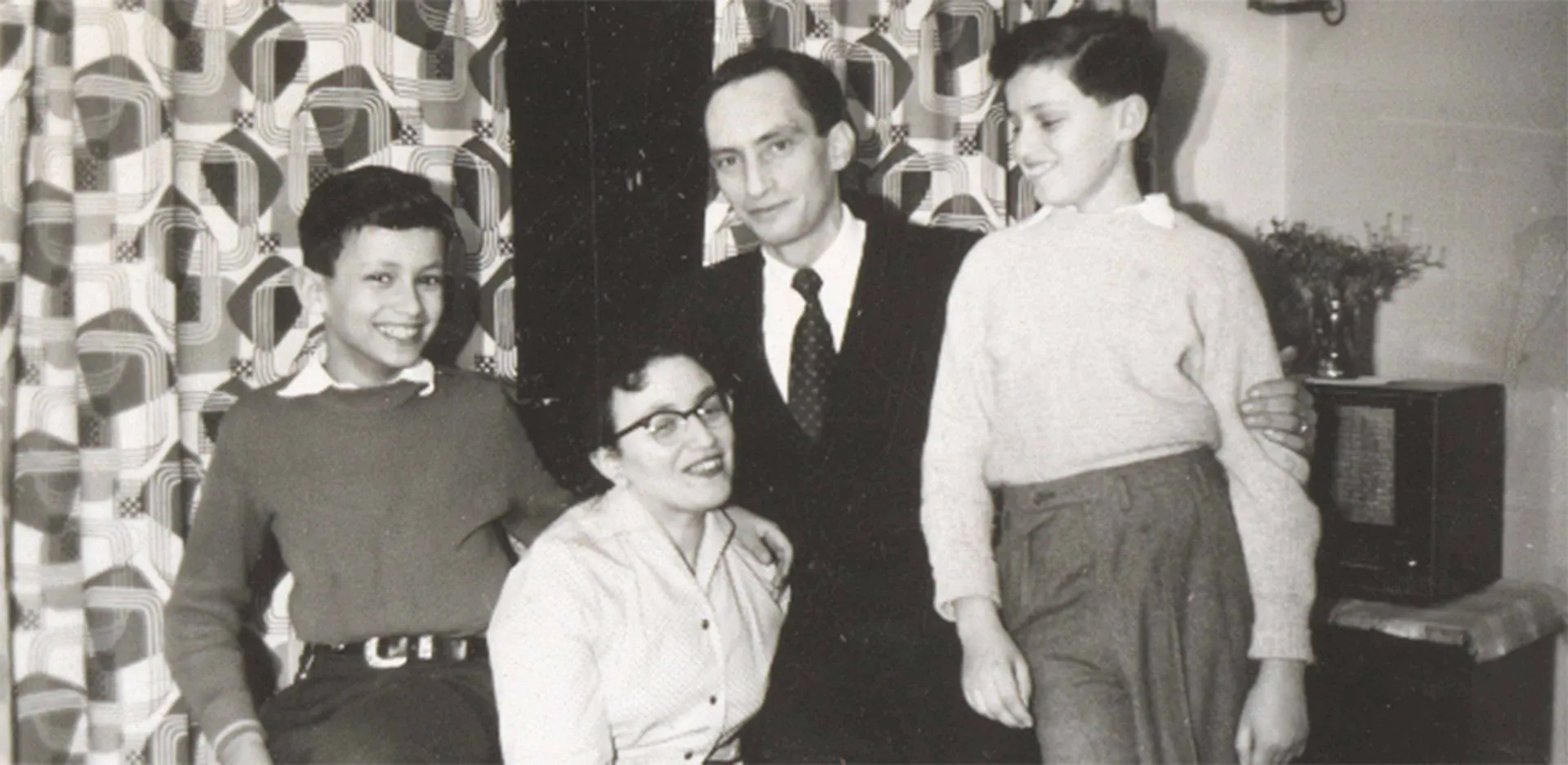
The Frankenstein family at their home in Bandhagen, near Stockholm. From left to right: Michael, Leonie, Walter, and Peter-Uri, around 1956–1957; Jewish Museum Berlin, accession 2010/165/5/001, gift of Leonie and Walter Frankenstein
Who are our donors? How do we receive gifts? And what can a museum do with donated objects and artifacts?
The example of the Walter and Leonie Frankenstein Collection – which comprises more than 1,000 photographs testifying to major twentieth-century events and their impacts on the lives of one family – offer some answers to these questions...
How It All Began
Walter and Leonie Frankenstein met Theresia Ziehe, Curator of Photography at the Jewish Museum Berlin, in Stockholm back in 2008.
Right away, Theresia Ziehe was moved by this encounter and struck by the Frankensteins’ profound partnership. After 66 years of marriage, the Frankensteins still radiated love and a deeply held respect for each other. The author Klaus Hillenbrand, who tells the Frankenstein’s life story in Nicht mit uns (Not with Us), sums up this impression at the end of his book with a question he asks the couple:
“‘Does ideal love exist?’ Leonie looks at Walter. And Walter looks at Leonie. And then they give the shortest possible answer, as if speaking from one mouth: ‘Yes!’”
At the first meeting, Walter and Leonie Frankenstein donated the first photo albums and documents to the museum. And after Leonie’s death in May 2009, Walter sought contact with us and gave further keepsakes, so that the entire body of items related to the couple is now in the Jewish Museum’s collection—consisting of more than 1,100 photographs, documents, and objects.
This collection is remarkable particularly in terms of its photographs because it visually depicts Walter Frankenstein’s entire life and the historical events reflected in it. Walter was born in 1924 and grew up in Złotów (German: Flatow, now part of Poland). Due to anti-Semitic hostilities, in 1936 he was sent to the Auerbach Jewish Orphanage in Berlin, where he met Leonie. He completed an apprenticeship, then came forced labor. Leonie and Walter married in 1942. One year later, they decided to go underground. Their two sons were born in 1943 and 1944. All of them survived National Socialism. In November 1945, Leonie managed to emigrate to Palestine with the two boys. After working in a displaced persons camp in Greifenberg, Walter also tried to travel to Palestine, but he was detained on Cyprus. He was released in late summer of 1947 and the family was finally reunited. In 1956, they moved to Stockholm. Walter Frankenstein lived there until his death in April 2025.
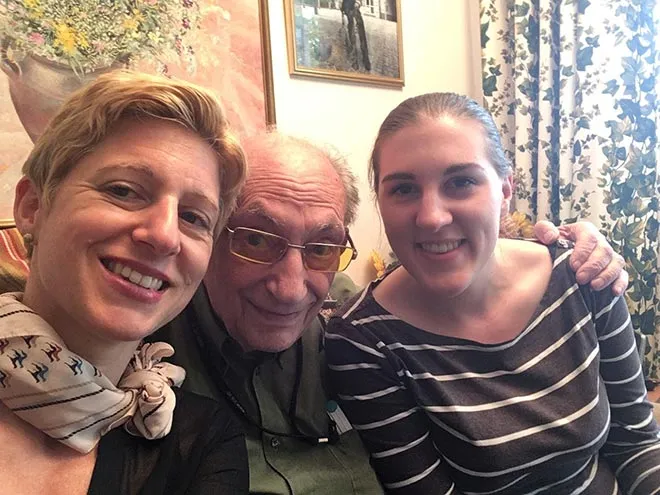 X
X
Walter Frankenstein with Anna Rosemann and Theresia Ziehe in Stockholm, 2017; Jewish Museum Berlin, photo: Theresia Ziehe
In 2017, numerous images from this collection were published in the online collections of the Jewish Museum (in German). Their online publication was accompanied by Anna Rosemann’s text below, which initially appeared as a six-part series on the Jewish Museum Berlin’s blog.
This presentation of the Frankenstein Collection required extensive preparation: All of the photographs were inventoried, opened to scholarship, and contextualized through extensive research. The most important basis for the time-consuming preparation of the collection were numerous meetings with Walter Frankenstein, and his trust in our work, for which we would like to offer him our heartfelt thanks. His impressive memory provided much context for individual photographs, including the names of those pictured.
Walter Frankenstein made it his life’s work to tell as many people as possible about his experiences. He frequently visits the Jewish Museum as a historical eyewitness. His wife is present at every event in the form of a large framed photographic portrait, which he begins by placing in a prominent location.
A Childhood in Flatow
Anna Rosemann
When I look at the picture of the infant in his baby carriage, it’s difficult for me to believe that it’s the same person who sat across from me just a few weeks ago in Stockholm at the age of nearly ninety-three years. It’s even harder for me to imagine the eventful life that lay between these two moments, which was shaped by a variety of sudden and in some cases tragic developments, as well as bold new starts.
I’m referring to the life of Walter Frankenstein, who donated more than 1,100 photographs to the Jewish Museum Berlin. Photos that depict his entire life from the earliest days of his childhood into old age.
The picture of the baby carriage is the oldest photo among them. It shows Walter in February 1925 at the age of 7-1/2 months on a sidewalk in his hometown of Flatow (today known as Złotów), where he was born on June 30, 1924. His father, Max Frankenstein, owned a country shop and an inn there, which he had inherited from the parents of his first wife, Emma Frankenstein. After Emma died of sepsis in 1917, he married Walter’s mother, Martha Frankenstein née Fein.
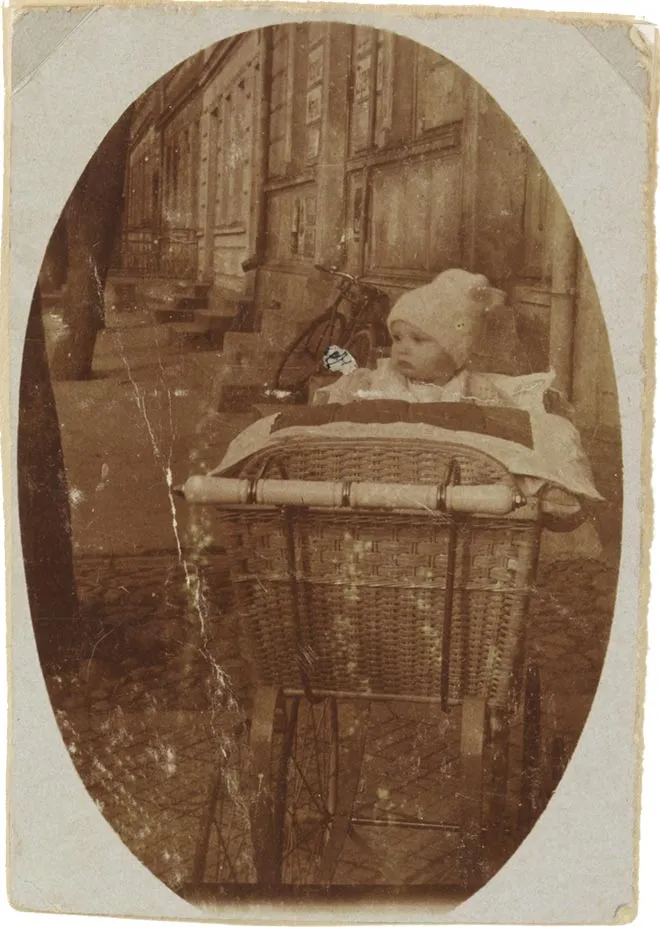 X
X
Walter Frankenstein in a baby carriage at the age of 7-1/2 months, Flatow, February 1925; Jewish Museum Berlin, accession 2011/73/10/001, gift of Leonie and Walter Frankenstein
Although Walter Frankenstein stares somewhat sullenly into the lens in a photo from 1928, he spent the first happy years of his life in a loving environment. In the photo, Walter is dressed up as a Prussian Hussar. The costume was a gift from his uncle Selmar Frankenstein, who was an Oberstabsarzt (a medical staff officer on the level of a major or lieutenant commander) in the First World War in Hindenburg’s headquarters near Tannenberg, and also served as personal doctor to Crown Prince Rupprecht of Bavaria, for which he received several military decorations. He also wanted to instill his nephew with his patriotic, German nationalist outlook. Judging by the expression on Walter’s face, his measures met with only modest success.
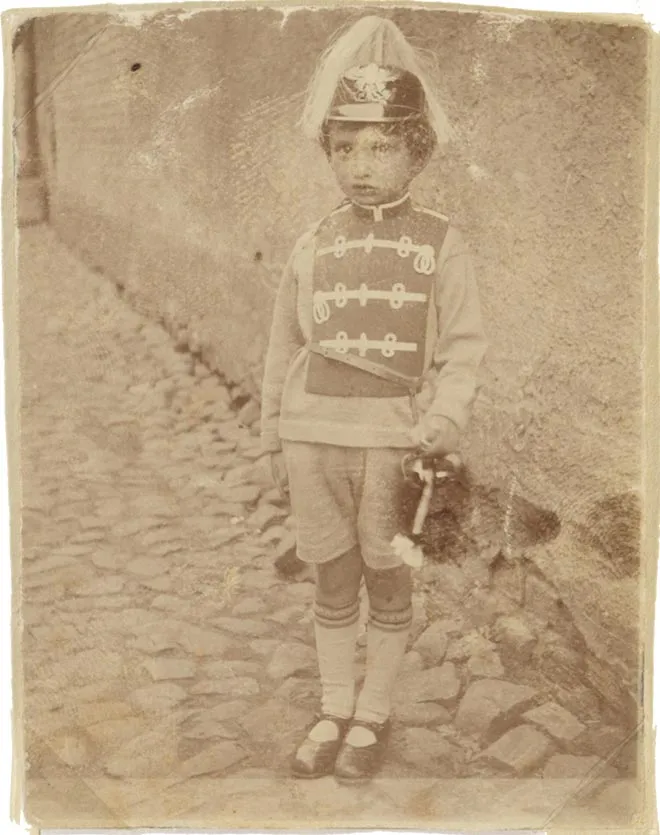 X
X
Walter Frankenstein dressed as a Prussian Hussar, Flatow, fall 1928; Jewish Museum Berlin, accession 2011/73/10/007, gift of Leonie and Walter Frankenstein
Walter Frankenstein was less for the military than for any and all types of transportation. He received a scooter for Easter in 1931, which only partially quenched his thirst for adventure. In order to increase his chances of going on a flight with a Junker, he “got engaged” that year to his Christian girlfriend Ingeborg Abraham, whose father was an airmail pilot. But the flight never came to pass, because Ingeborg and her parents soon moved away.
Beginning in 1933, his remaining Christian friends in Flatow began to pull away from Walter. In 1934, Walter’s brother Martin Frankenstein emigrated to Palestine—another early consequence of the National Socialists coming to power.
Martin had completed a business apprenticeship in the family’s clothing and ready-to-wear garment company in Bischofsburg, East Prussia (today: Biskupiec). After moving to Rishon leZion, Palestine, he worked as a mailman.
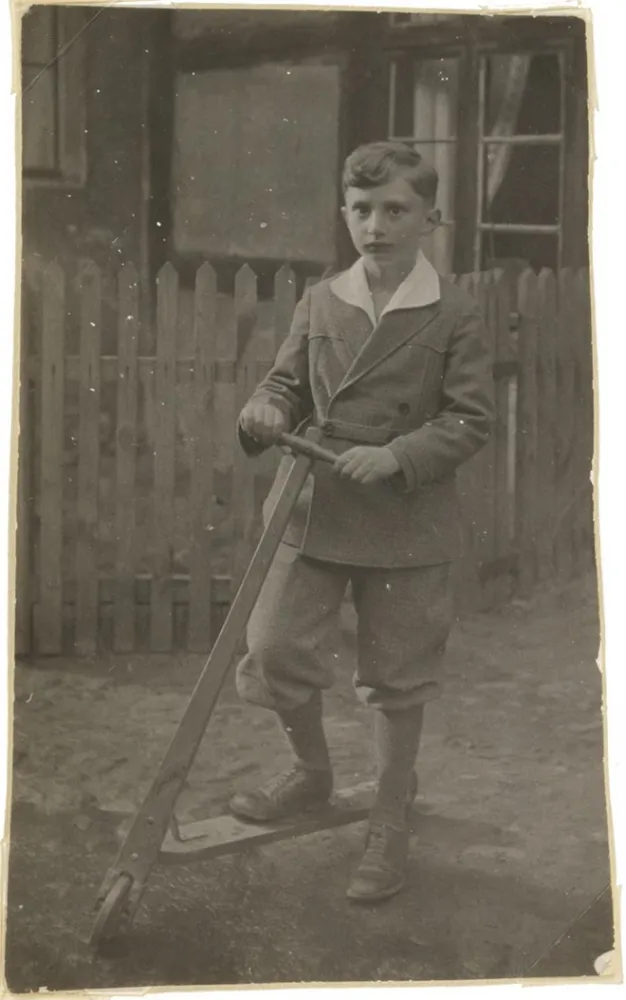 X
X
Walter Frankenstein with his new scooter, Flatow, Easter 1931; Jewish Museum Berlin, accession 2011/73/11/003, gift of Leonie and Walter Frankenstein
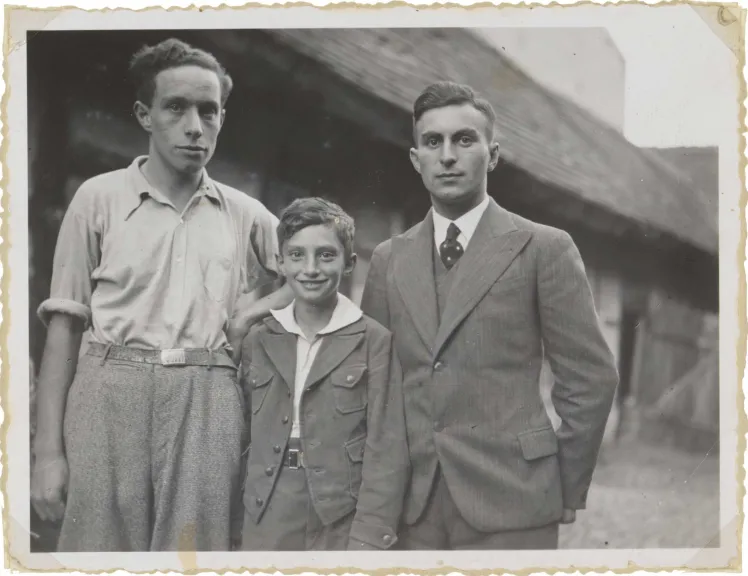
From left to right: Martin Frankenstein (1914–1982) with his brothers Walter and Manfred (1910–1969) on the day before his emigration, Flatow, 1934; Jewish Museum Berlin, accession 2011/73/13/003, gift of Leonie and Walter Frankenstein
The keepsake photo shot one day before his departure also shows Walter and Martin’s brother Manfred, who followed him to Palestine in 1937. Both Martin and Manfred were disinherited by their childless uncle Selmar. He viewed emigration to Palestine as betrayal of the fatherland.
Unlike his brothers, Walter remained in Germany, experiencing the increasing repressive measures taken by the National Socialist government against Jews. On April 1, 1933, when a boycott of Jewish businesses was declared, an unknown party shot at the windows of the Frankenstein’s shop, which Martha Frankenstein had run alone since her husband’s death in 1929.
Walter told himself on that night:
“Dear God, if this man doesn’t drop dead in the next fifty meters, then I won’t believe in you anymore.”
He sums it up today:
“He didn’t drop dead and I became an atheist. I still am, to this day.”
Despite this drastic experience, Walter’s mother continued to run the shop for a while. It is pictured on the following photo where Walter and Martha Frankensein (1885–1943) are standing in the doorway.
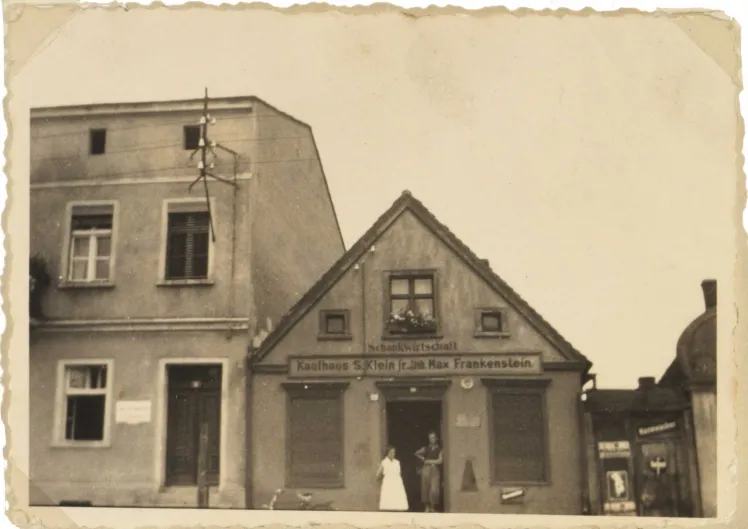
View of the Frankenstein family home in Flatow, Flatow, 1935; Jewish Museum Berlin, accession 2011/73/8/006, gift of Leonie and Walter Frankenstein
The picture is also the last remaining shot of Walter in the town of his birth. Shortly thereafter, in summer 1936, twelve-year-old Walter was forbidden from attending the Christian school in Flatow. He had to move to the Auerbach Jewish Orphanage in Berlin, where the next chapter in his life begins.
Growing up in the Auerbach Orphanage
Jesse Owens – this name means something to most people, even today. The black athlete from the U.S. national team decided in 1936, disregarding the expectations and fears of his family, friends, and a large number of Americans, to compete in the Olympics in Berlin. In light of the political climate prevailing in the place where the Olympics were to be held – where Antisemitism, propaganda, and violence against minorities were routine aspects of life, international opinion placed little stock in the chances of a fair competition among the athletes.
For Walter Frankenstein, the name Owens was closely tied to the experience of moving from his home town of Flatow (today Złotów) in what was then West Prussia to Berlin. When he arrived by train at the Alexanderplatz station on 27 July 1936, preparations for the Summer Olympics to be held in the German capital were in full swing. Walter attended the event with an uncle on his mother’s side and thus had the opportunity to see Jesse Owens competing live in Berlin’s Olympic Stadium. Owens was the most successful male athlete of the Games, winning four gold medals.
In that summer of Olympic fever, Walter’s uncle Selmar Frankenstein entrusted him to the Baruch-Auerbach´schen Waisenerziehungsanstalten – the Auerbach Orphanage. This private orphanage, founded in 1832, cared for both boys and girls without parents. In 1897, the institution had moved into a new building that housed its own synagogue at Schönhauser Allee 162.
Walter was not just a passionate fan of sporting events. He himself competed in track and field, boxing, soccer, and the German sport of handball as a member of the Jewish Club Maccabi. At the Auerbach Orphanage, as well, sports formed an important part of the school curriculum. There were regular competitions among the wards of the orphanage, but also between the Orphanage team and students of the Jewish School in Berlin’s Rykestrasse.
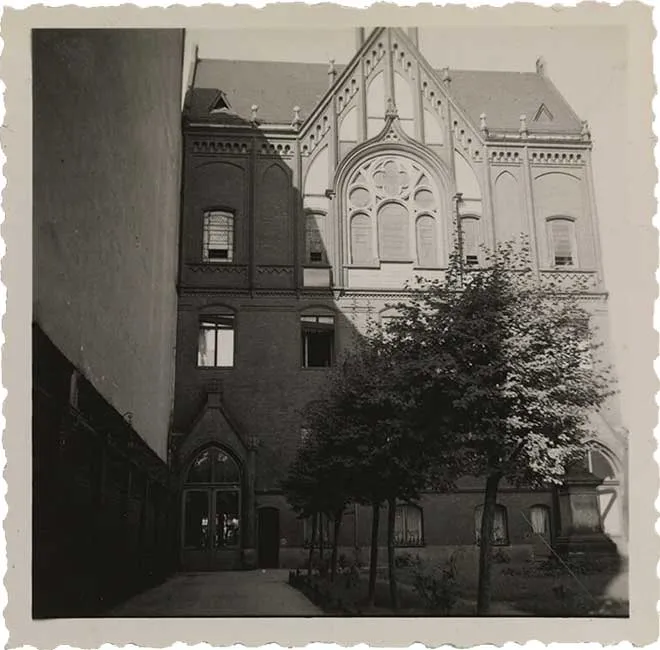 X
X
Exterior view of the Auerbach Jewish Orphanage, Berlin, around 1940–1944; Jewish Museum Berlin, accession 2008/311/79/001, gift of Leonie and Walter Frankenstein
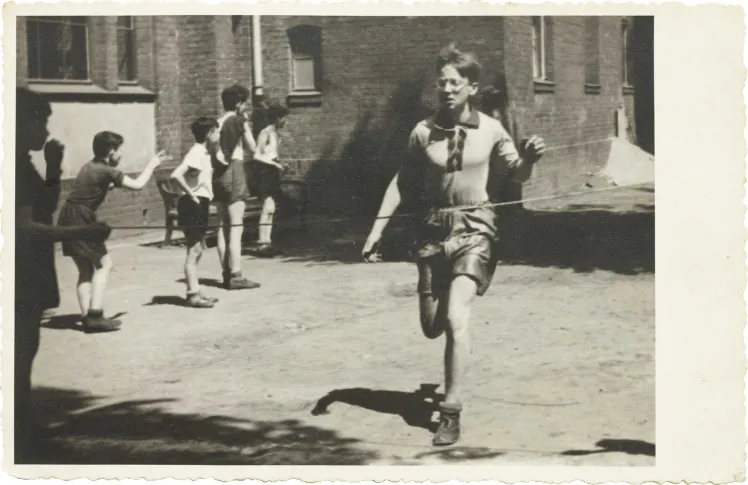
Kurt Gumpert (1924–1943) running a race, Berlin, 1936–1942; Jewish Museum Berlin, accession 2008/311/45/002, gift of Leonie and Walter Frankenstein
Walter captured moments from these sporting events – such as his friend Kurt Gumpert crossing the finish line – on film with the camera which he had been given for his birthday in 1936.
Walter documented in photographs not only special events, but also the everyday life of the orphanage. Thus we can still see today how Erwin Panthauer’s face looked as he was being served rice gruel. Selma Plauts, the Orphanage Director’s wife, had ordered that gruel be served twice a week to all wards of the orphanage who looked a little “weak.” Walter, who belonged to this group, was able to get rid of the gruel by a kind of trade: Erwin ate Walter’s gruel and, as payment for that favor, also got to eat the piece of cake that Walter, like every ward of the orphanage, received on Saturday morning in celebration of Shabbat.
Up to that point in time, the Auerbach Orphanage had functioned as a refuge for 200 children and young people. Walter reports about this period: “We lived there as if on a small, sheltered island. We didn’t really have much experience with persecution until the pogrom of ‘Reichskristallnacht’ in 1938.”
But on that night, a gang of plundering Nazi Storm Troopers bent on arson burst into the orphanage. Walter and three other young men tried to stop them. They insisted that there were many children and young people living in the house, and that the closely neighboring buildings could easily catch fire, too. The Storm Troopers withdrew, but as they did so blew out the Eternal Flame on the altar of the synagogue and opened the gas valve all the way. Fortunately, Walter and his friends noticed that the gas was flowing out freely and were able to prevent the worst from happening.
Afterwards, the four boys climbed onto the roof of the orphanage. From there, they could see the fires raging all over the city. A photograph of this night has not survived. But as someone who has acted as passionate caretaker for the Frankenstein Collection and conducted research on Walter’s life, the mere thought of what Walter and the others must have witnessed at that moment makes me shudder.
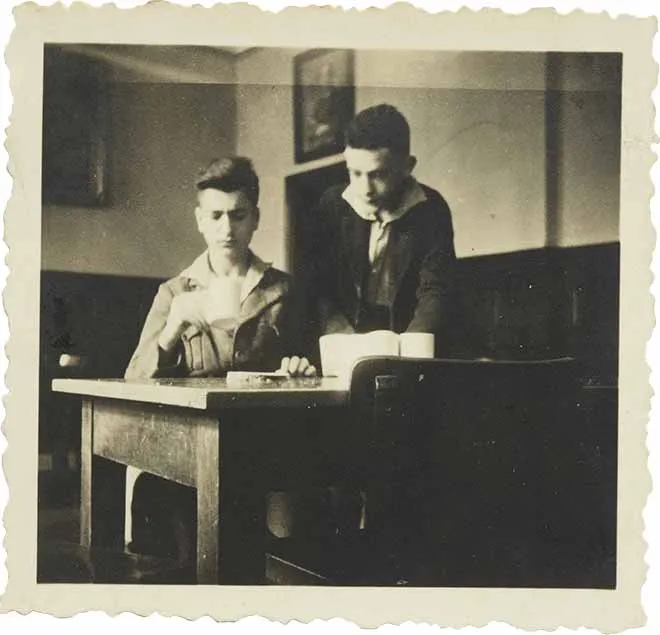 X
X
Erwin Panthauer (1925–2008) is served rice gruel by Gerd Punscher (1924–1942), Berlin 1936–1938; Jewish Museum Berlin, accession 2008/311/31/002, gift of Leonie and Walter Frankenstein
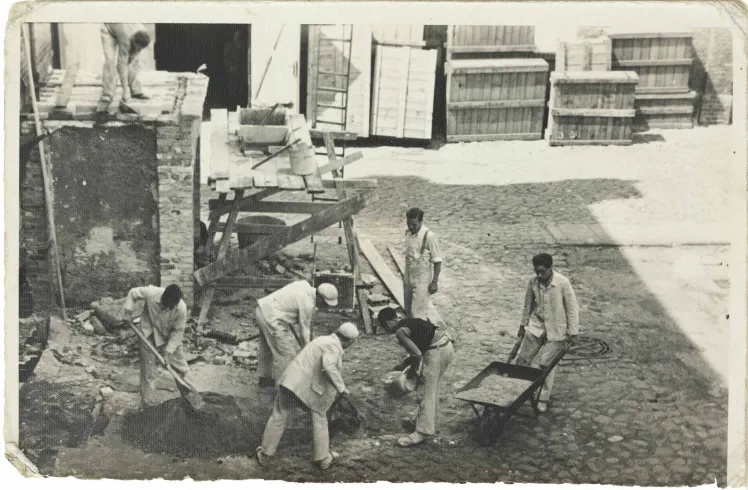
Apprentices at the Jewish Building School performing masonry work, Berlin 1938–1941; Jewish Museum Berlin, accession 2008/311/72/005, gift of Leonie and Walter Frankenstein
A short time later, Walter Frankenstein left the Auerbach Orphanage and moved into the Jewish Orphanage in Pankow. Since graduating from the Jewish Technical Secondary School in 1938, he had been training as apprentice mason at the Jewish School of Construction at the Ostbahnhof in Berlin. But his stay in Pankow proved to be a short one. The orphanage was shut down in 1940 and all the children and young people living there were sent back to the Auerbach Orphanage. Walter returned to the place where he had spent a happy youth, and where he would soon meet the woman of his life.
A Life Underground
“Her and no one else,”
said Walter Frankenstein the first time he saw his future wife Leonie Rosner in the courtyard of the Auerbach Jewish Orphanage. Leonie was from Leipzig and in Berlin she had begun training at the Jewish Seminar for Nursery School Teachers.
After it was closed, she came to the Auerbach Jewish Orphanage as an apprentice. Soon after her arrival, Leonie’s room quickly became the place where apprentices living in the orphanage met. Seventeen-year-old Walter grew closer to Leonie (three years his senior) over conversations about religion, Judaism, emigration to Palestine, and daily life. In fall 1941, after the director threatened to fire Leonie over her behavior toward a student, the young couple decided to leave “Auerbach”. Walter and Leonie subletted a room with the Mendel family in Prenzlauer Berg. Soon after that they decided to get married. They had heard that married couples would be spared deportation. Under-aged Walter had to get his mother’s permission for the wedding, which took place on February 10, 1942.
At this point, Walter Frankenstein earned his living as a tradesman for the Jewish Community after the Jewish Construction School was closed. As an employee of the Community, he had to perform forced labor, which once brought him to the official residence of Adolf Eichmann on Kurfürstenstraße. “One speck and you’re in Auschwitz tomorrow,”
the S.S. Obersturmbannführer (lieutenant colonel) threatened Walter as he plastered over a telephone line in Eichmann’s office.
Leonie Frankenstein also had to suffer through forced labor. She became pregnant shortly after the wedding and was relegated to a factory for tethered balloons. The smell of glue in the factory was unbearable. Leonie regularly fainted at work. She asked her overseer if she could be transferred elsewhere and was placed in a factory for transformer coils. She worked there until one week before the birth of her son Uri Frankenstein on January 20, 1943. Uri was born in the Jewish Hospital and was circumcised against his parents’ wishes. Leonie and Walter feared that it would make their child identifiable as Jewish.
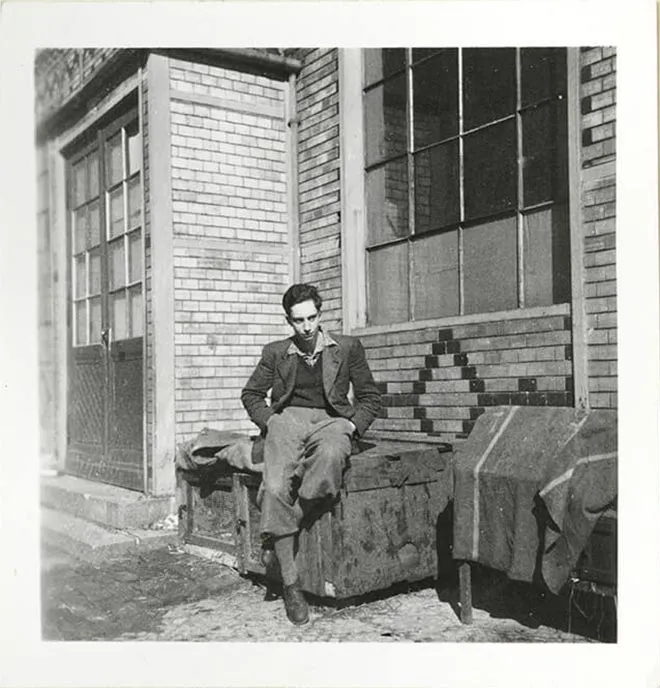 X
X
Walter Frankenstein in front of the gymnasium at the Jewish Orphanage, Pankow, Berlin 1938–1940; Jewish Museum Berlin, accession 2008/311/55/006, gift of Leonie and Walter Frankenstein
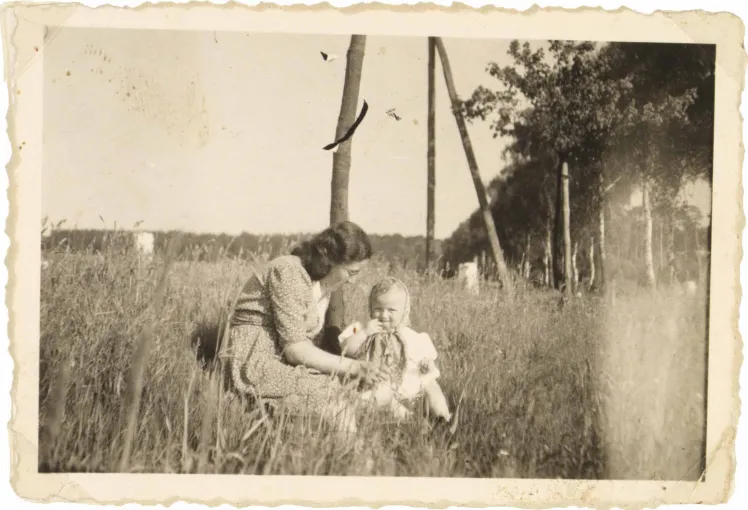
Leonie Frankenstein (1921–2009) with her son Peter-Uri (born 1943) sitting in a meadow, Brzeźno in Gorzów County (German: Briesenhorst), May 1944; Jewish Museum Berlin, accession 2011/73/41/004, gift of Leonie and Walter Frankenstein
Beginning in 1943, the situation of Jews in Germany became ever more dangerous. The deportation of German Jews to concentration camps and death camps in the east had reached an advanced stage. One morning at the end of February 1943, it became apparent to Walter how dangerous the situation was for his family: at his place of employment at Bayrisher Platz in Schöneberg, Berlin, the only person present was an official from the Gestapo. None of his colleagues were there. He learned from the official that they had been deported the night before. When his overseer inquired as to what they should do with Walter, he fled immediately. Just a few days later, Leonie escaped an order to appear with her six-week-old son at the detention camp at Große Hamburger Straße, and the family decided that going underground was the only way to survive.
During Leonie’s second pregnancy in 1944, she registered under a false identity at a center for people displaced by bombings, and was sent to Briesenhorst as a “German mother” with Uri. She spent the spring and summer there with a farm-woman and her daughter. There are a few photos that have survived from this time depicting the Frankenstein family’s life underground. They show Leonie and Uri on the farm. Leonie’s contractions began at the end of September 1944. She had to go to a hospital in Landsberg an der Warthe (now Gorzów Wielkopolski), and after the birth of her son Michael on September 26, 1944, she had to stay there for another three weeks due to an infection. She constantly thought about the fact that Uri was circumcised and therefore clearly identifiable to the farmer as a Jewish child. However, when she returned to the farm, she found Uri well-fed and taken care of. The farmer never said a word about the origins of the boy and his mother.
Walter also had good luck on a few occasions. In 1944, after another night spent in bombed-out ruins, he was riding on the S-Bahn train. He usually always stood next to the door in case of inspections. But he was very tired, so he sat down and nodded off. He didn’t wake up until a so-called Kettenhund (a military policeman, literally “guard dog”) was demanding his papers. Walter said in a fake accent that he was a foreign forced laborer who had forgotten his identification in his work clothing. The officer suggested they get out at Friedrichstraße Station. He planned to call Walter’s supposed employer from a police precinct there and inquire about his identity. After both men got off the train, Walter saw no other option than to admit to the officer that he was a Jew living illegally in Berlin, and if the officer reported to him, to be deported to Auschwitz the next day. After considering it briefly, the Kettenhund told Walter “Get lost, I’m not looking for Jews, I’m looking for deserters.”
These stories are just two examples of how Walter, Leonie, Uri, and Michael survived their time underground. On April 27, 1945, the four Frankensteins witnessed Germany’s liberation by the Soviet Army. Their horror and fear had finally come to an end—and now an uncertain future lay before them.
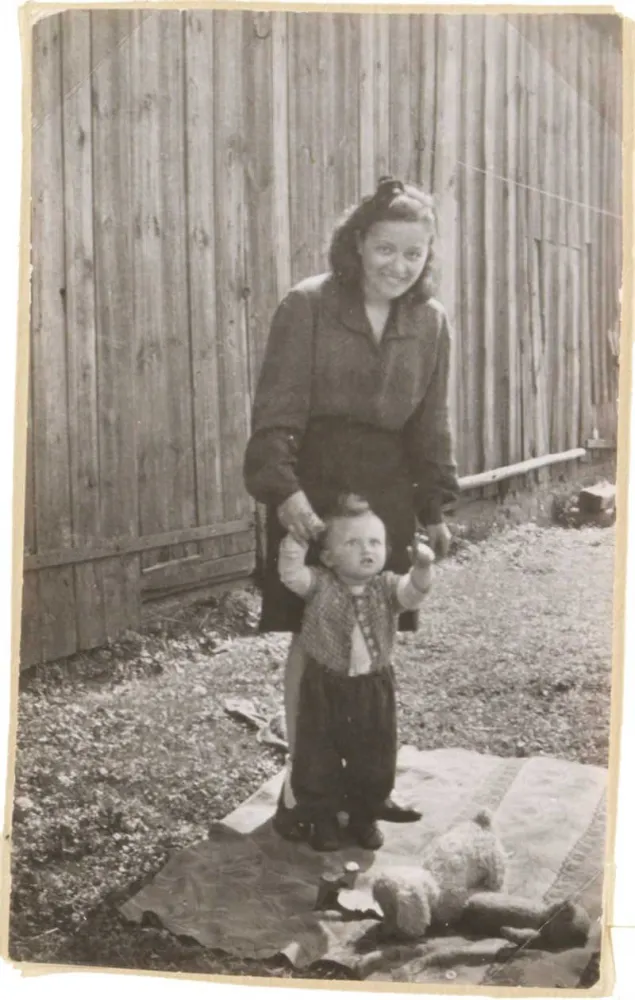 X
X
Leonie Frankenstein holds her son Peter-Uri by the hands, Brzeźno in Gorzów County (German: Briesenhorst), 1944; Jewish Museum Berlin, accession 2011/73/41/003, gift of Leonie and Walter Frankenstein
A New Beginning
What were they to do now? Nothing was left of the Frankensteins’ old life. Their relatives and friends had been murdered, including Walter and Leonie’s mothers. All of Europe lay in ruins.
The first step in the Frankensteins’ new life was a simple administrative act: they registered with the Jewish Community of Berlin and were assigned an apartment. However, due to the bad supply situation, they were advised to leave Berlin as soon as possible. Nevertheless, they decided to spend the summer in Berlin. Walter volunteered as a manager for the Neukölln Leisure Games. At the same time, he made contact with the Jewish Brigade. Over the course of the war, the British Mandate government had drastically reduced the channels for legally entering Palestine. That meant that for the roughly 250,000 displaced persons ( DPs) in camps in western Europe, illegal entry was often the only way to reach Palestine. Walter managed to arrange an opportunity for legal emigration for Leonie and the children through the members of the Jewish Brigade. In return, he promised to smuggle young Jews southward through Germany for the Brigade. Their destinations were harbors on the Mediterranean where underground Jewish organizations prepared ships for their illegal entry into Palestine.
In mid-November 1945, Leonie left Berlin with her two sons and headed for Palestine. Four weeks later, the Jewish Brigade sent Walter to Greifenberg on Lake Ammer, via Munich and DP Camp Landsberg. A sort of kibbutz had been established there in a former school for regional leaders of the League of German Girls (Bund Deutscher Mädel) Young men and women who had survived the concentration camps, as well as partisans were supposed to be psychologically rehabilitated there and prepared for emigration.
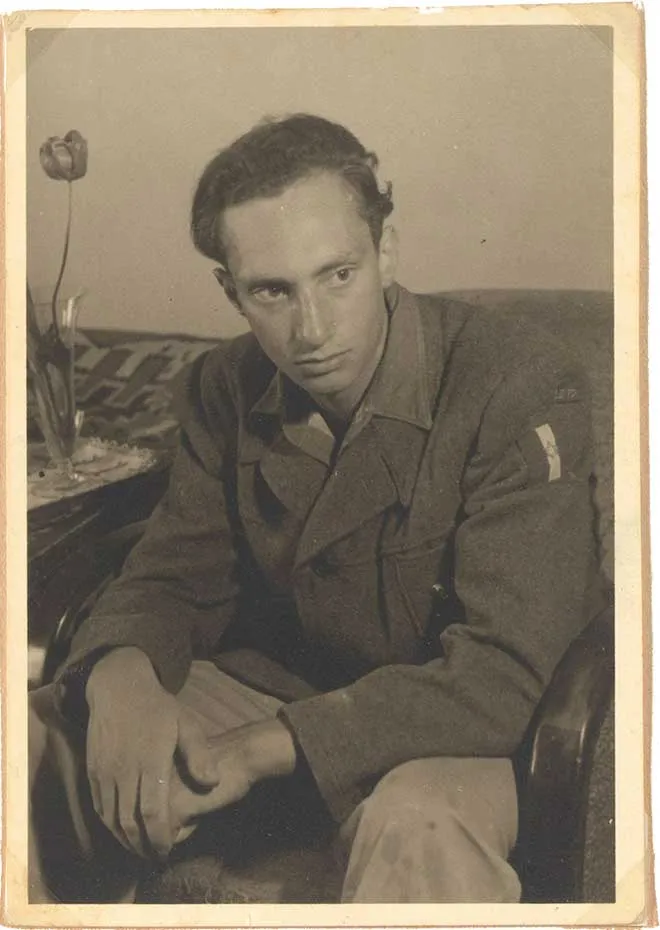 X
X
Walter Frankenstein during his time in the kibbutz, Greifenberg, around December 1945–May 1946; Jewish Museum Berlin, accession 2010/164/10/006, gift of Leonie and Walter Frankenstein
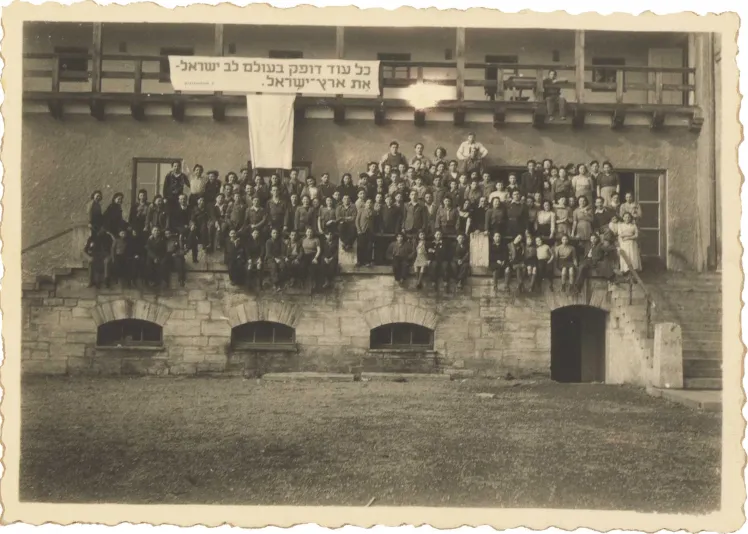
Group picture of kibbutz residents, Greifenberg, around 1946; Jewish Museum Berlin, accession 2010/164/6/003, gift of Leonie and Walter Frankenstein
This group picture of the residents makes the kibbutz’s principles clear. The men and women are posed under a banner with a quote from a song by Pooa Grinshpon, which reads: “As long as the heart of Israel [meaning the Israelites] is still beating [somewhere] in the world—the Land of Israel!”
It is evident how pronounced the solidarity of the residents with the Zionist movement was at this point in time, as well as their will to emigrate to Palestine and their willingness to found an Israeli state. Walter—who taught jujutsu in the camp, managed the kitchen, and organized the smuggling of people over the border—was no exception. In a portrait from his time in Greifenberg, he posed with a jacket bearing the insignia of the Jewish Brigade.
Although Walter had been assured that he could follow Leonie and the children to Palestine within six weeks, months had passed. In May 1946, he finally traveled to La Ciotat, near Marseille. He was supposed to ensure that the passengers of the ship Latrun had food and water on their illegal entry voyage. The Latrun set out for Haifa on October 19, 1946, with approximately 1,248 people on board the ship originally intended for 75 passengers. According to his own statements, during the crossing Walter smoked 140 cigarettes daily and hardly slept for seven days. Even if it isn’t absolutely accurate, 140 cigarettes is a number that is symbolic of the extreme conditions under which people hazarded their illegal emigration to Palestine. Above all, they had one goal: to get away from Europe.
The passengers of the Latrun didn’t manage to do so one the first attempt. After the ship raised the Israeli flag off of Cyprus, it was boarded by the British when it entered Palestinian waters, and then directed to the harbor at Haifa. But instead of stepping onto land, the passengers had to divide themselves between two British cruisers that brought them to a detention camp on Cyprus. Walter began to cook for a group of 20 people again, and also made an effort to make their free time as pleasant as possible for the men and women.
Photos from the Internment Camp in Cyprus
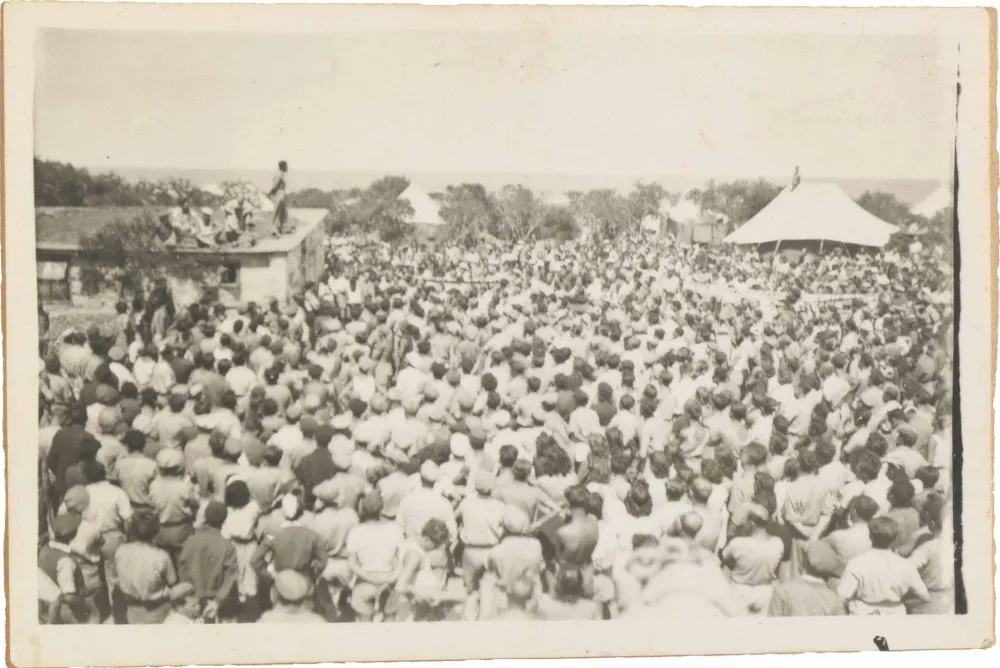
Prisoners demonstrating in an internment camp, near Famagusta, May 1947; Jewish Museum Berlin, accession 2010/164/17/001, gift of Leonie and Walter Frankenstein
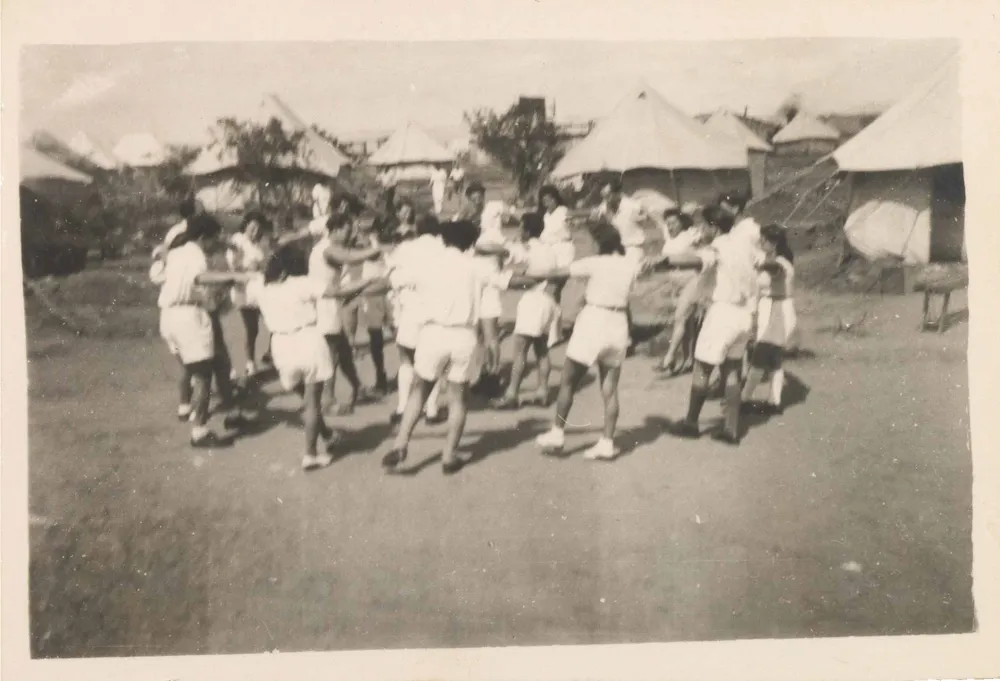
Walter Frankenstein’s group at the internment camp dancing the hora, Famagusta, spring 1947; Jewish Museum Berlin, accession 2010/164/18/004, gift of Leonie and Walter Frankenstein
In June of 1947, Walter was finally transferred to the transit camp Atlit in Palestine. He saw his family for the first time after roughly 19 months of separation through the barbed wire fence depicted in the photo. After a brief stay in the Kiryat Shmuel camp, Walter was released in August/September 1947. Finally, he could begin to build a life together with Leonie in Palestine…
Not What They Expected
Finally reunited after 19 months! —A summer 1947 photo of Leonie, Uri, and Michael Frankenstein makes clear how overjoyed the three were about Walter’s release. All three gaze relieved into the camera.
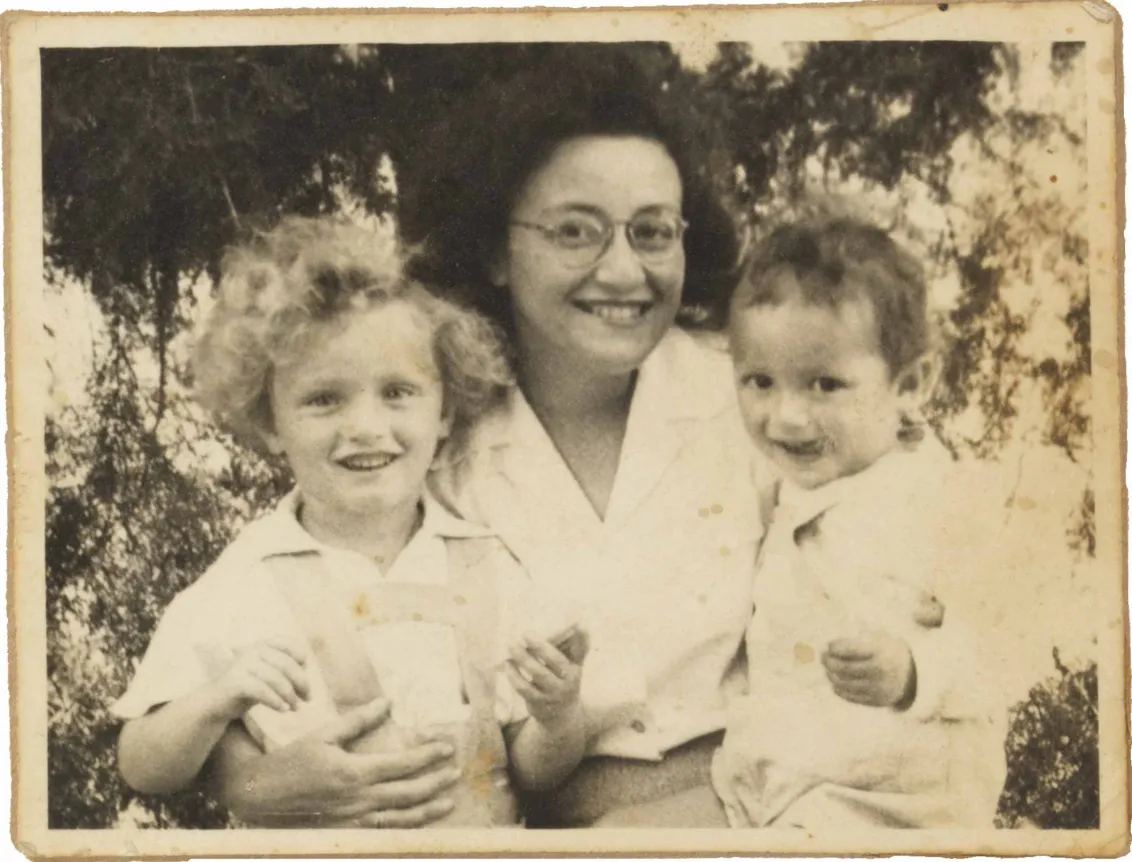
Leonie Frankenstein with her sons Peter-Uri (born 1943) and Michael (born 1944), Hadera, 1947; Jewish Museum Berlin, accession 2011/139/3/001, gift of Leonie and Walter Frankenstein
At first, Walter moved into the one-room apartment in a public housing building in Hadera that had been allocated to Leonie and the children following their emigration to Palestine. In the mean time, Leonie had learned Hebrew and found employment at a chocolate shop. Her work had allowed her to support herself and her sons in her husband’s absence.
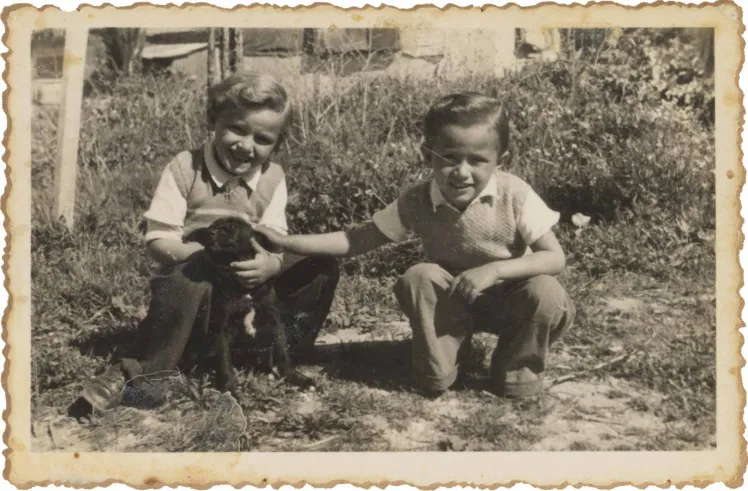
Brothers Peter-Uri and Michael Frankenstein with a puppy, Hadera, 1949; Jewish Museum Berlin, accession 2011/139/4/005, gift of Leonie and Walter Frankenstein
After being reunited, the four Frankensteins moved into a building in Neve Hayim, a district of Hadera. There wasn’t any electricity in their new home, and the family had to get by with an alcohol stove, petroleum lamps, and warm water from an oven. Walter Frankenstein quickly found work as a tiler and mason in Palestine through his contact to Haganah, an underground Zionist paramilitary organization. For a brief period of time, the family could lead a normal everyday life.
But it didn’t last for long. Just one hour after the State of Israel declared its independence on May 14, 1948, Walter was conscripted into military service. He received personnel number 27,009 (the numbering began at 25,000)—and was assigned to the Givati Brigade. His unit first stopped the Egyptian invasion outside of Tel Aviv, and then ensured the provision of cut-off Jerusalem.
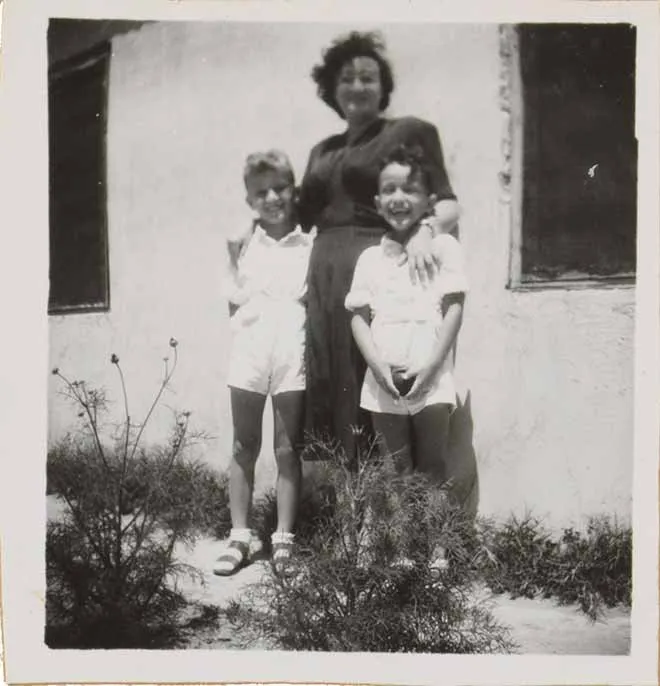 X
X
Leonie Frankenstein and her sons Peter-Uri and Michael Frankenstein standing in front of their home, Neve Hayim (Hadera), 1951; Jewish Museum Berlin, accession 2011/139/16/002, gift of Leonie and Walter Frankenstein
Walter was proud to be able to serve Israel, and felt himself to be a little cog that contributed to the founding of the state. He and his wife were idealists, and so Leonie allowed her husband to go to war without protest, though it may not have been easy. The proof is a photograph from Walter Frankenstein’s furlough, which has nothing in common with the photo of Leonie and her sons from the year before. Walter and Leonie seem tense in the picture.
The reason is obvious. From Walter’s unit of 75 men, only five had survived. Walter was lucky. During the heaviest fighting in mid-July 1948, he was in a military hospital with a knee injury. After the signing of the armistice agreements in spring and summer of 1949, in fall 1949, Walter was finally released from military service and resumed his work as a mason and tiler.
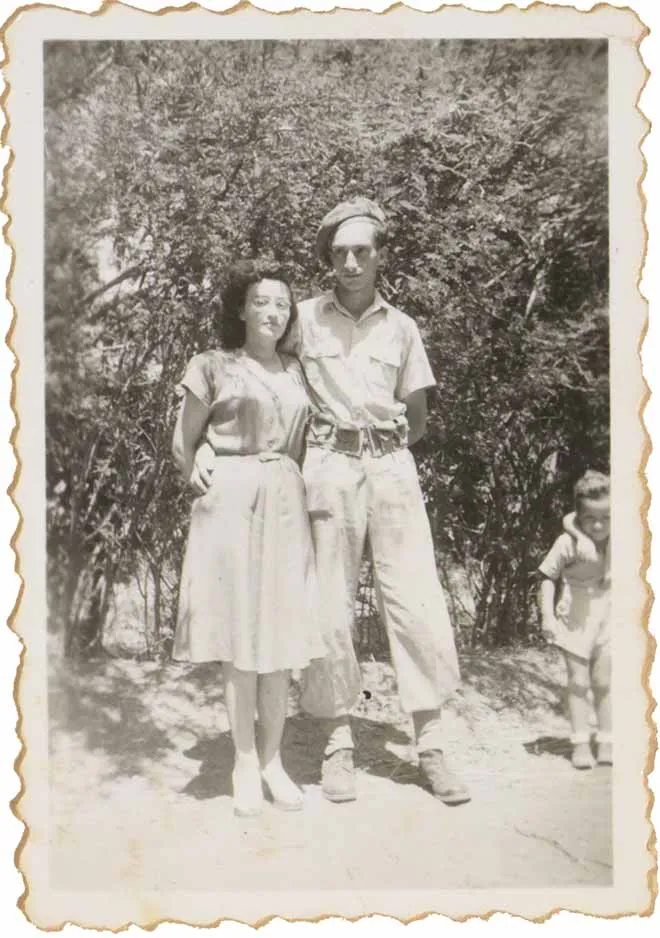 X
X
Walter Frankenstein with his wife Leonie during his military leave, Hadera, summer 1948; Jewish Museum Berlin, accession 2011/139/5/009, gift of Leonie and Walter Frankenstein
In 1953, together with a friend, Walter became self-employed. First, their company received a contract to install California-style irrigation systems in various kibbutzim in the Jordan valley, then to construct drainage canals for salt basins on the Dead Sea.
The high temperatures and hard work took a physical toll on Walter Frankenstein. Faced with the negative impact on his health and his family’s uncomfortable living situation (they were still without electricity after eleven years), it “all became too much”
for him, as he puts it today. The family decided to emigrate to Sweden, where Walter’s friend Rolf Rothschild lived. And so in summer 1956, the four Frankensteins departed from Israel to try a new beginning one final time.
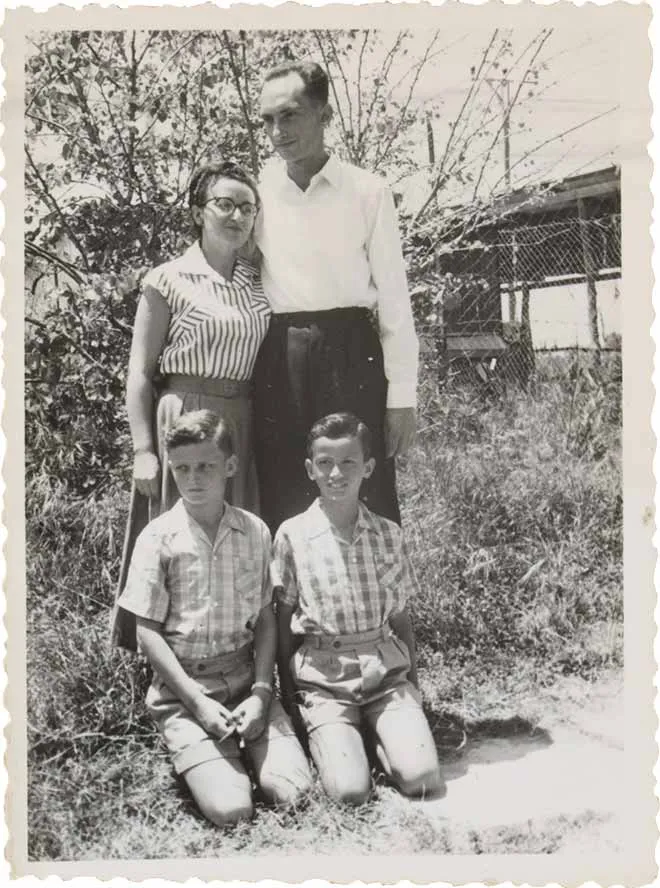 X
X
The Frankenstein family during their last summer in Israel, Neve Hayim (Hadera), summer 1956; Jewish Museum Berlin, accession 2011/139/19/001, gift of Leonie and Walter Frankenstein
A New Home in Sweden
To start from the beginning again: when I consider the path that Walter Frankenstein and his family took, I’m constantly astonished that they didn’t lose hope and always found new strength to confront the numerous changes in their lives. In 1956, the final big challenge in the lives of the four Frankensteins got underway.
In July, the Frankenstein family first traveled from Haifa via Naples to Dortmund, where Leonie’s stepfather Theodor Kranz lived. After Walter arrived in Sweden on July 27th, received his work permit, and found a position at a construction site at a subway station in Stockholm, Leonie, Uri, and Michael joined him in September.
At first, the four Frankensteins lived in Walter’s friend Rolf Rothschild’s studio apartment. Like Walter, Rolf spent his youth in the Auerbach Jewish Orphanage and had already emigrated to Sweden in 1939. Later he left the Frankensteins his two-room apartment in the Stockholm suburb of Bandhagen, which he had applied for shortly beforehand from a housing association. On November 15, 1956, Walter, Leonie, and their two sons moved into their new home, where they would spend the next 53 years.
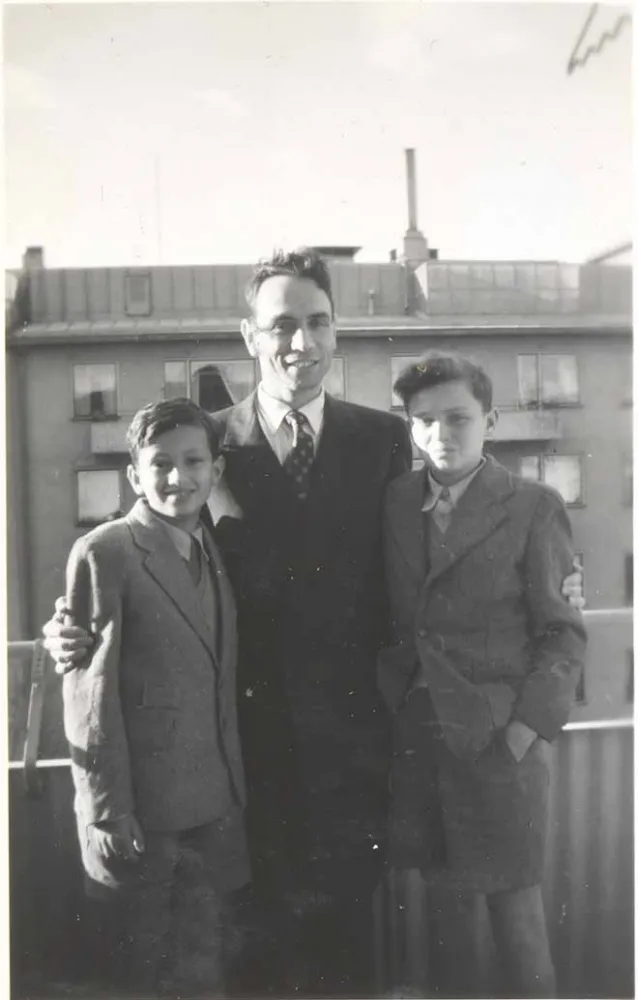 X
X
Rolf Rothschild (1923–1985) with Peter-Uri and Michael Frankenstein, Stockholm, around 1956; Jewish Museum Berlin, accession 2010/165/3/001, gift of Leonie and Walter Frankenstein
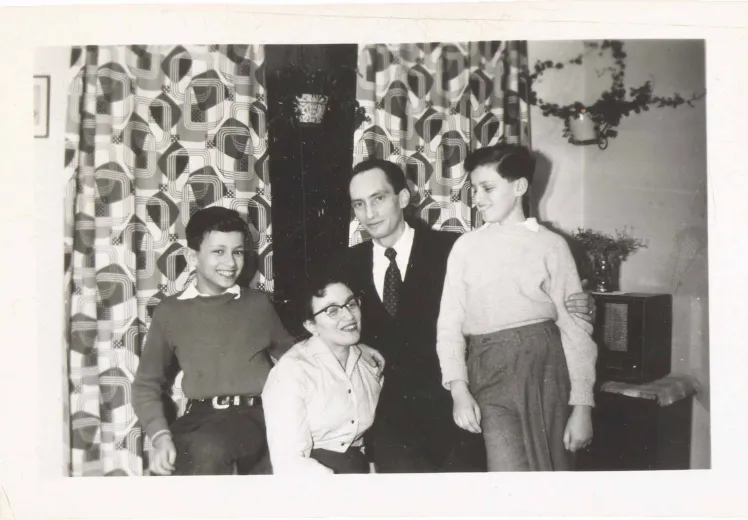
The Frankenstein family at their home in Bandhagen, near Stockholm. From left to right: Michael, Leonie, Walter, and Peter-Uri, around 1956–1957; Jewish Museum Berlin, accession 2010/165/5/001, gift of Leonie and Walter Frankenstein
Walter initially continued to work as a mason, but after 1965, he could no longer do so for health reasons. And so he started all over professionally. First he attained a secondary school degree, then began a university degree in civil engineering. After passing his exams in 1969 and 1970, he got a job as a structural engineer and draftsman at a globally active company, where he was involved in the construction of nuclear power plants, among other things. Beginning in the late 1950s, Leonie attended a commercial college and then found a position in the accounting department of a company.
In Sweden, the Frankenstein family finally had the chance to do what they wanted with their free time. Every summer they went to a vacation home in Sörmland, around 110 km south of Stockholm. In winter, they engaged in athletic activities in and around Bandhagen. Walter had been a sports enthusiast since his youth, and Leonie and the two boys also enjoyed sledding, skiing, and skating on the ice and snow.
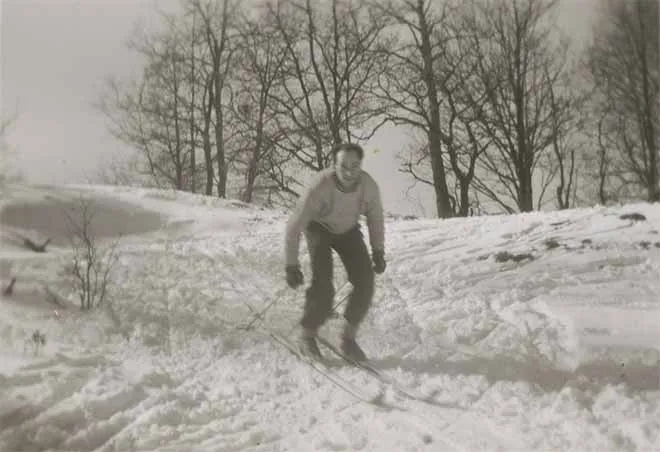 X
X
The Frankenstein family skiing, near Stockholm, around 1956–1957; Jewish Museum Berlin, accession 2010/165/8/005, gift of Leonie and Walter Frankenstein
In December, the family celebrated Hanukkah as well as Christmas in their little apartment. The four Frankensteins had had to do without this during their time in Israel, since there had simply been no Christmas trees to buy in Israel. Uri and Michael seemed to enjoy the holiday, as the photo of one of their first Christmases suggests.
After retiring in 1984, Walter frequently traveled with Leonie to the rest of Europe and to Israel. The two regularly visited Germany and especially their old home city of Berlin.
Walter and Leonie Frankenstein’s time together ended after 66 years of marriage when Leonie died on May 19, 2009.
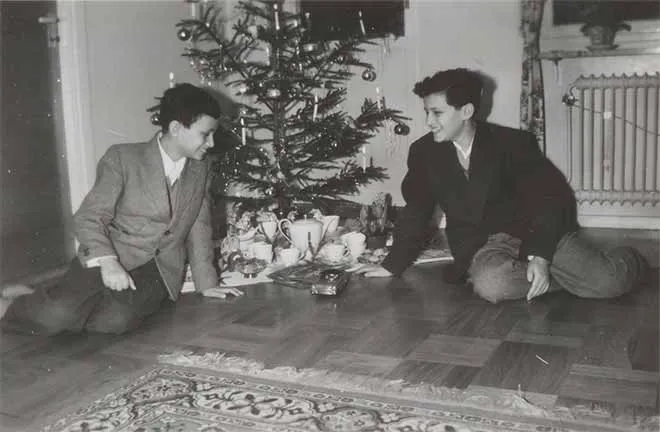 X
X
Peter-Uri and Michael Frankenstein sitting in front of the Christmas tree, Stockholm, around 1956–1957; Jewish Museum Berlin, accession 2010/165/6/005, gift of Leonie and Walter Frankenstein
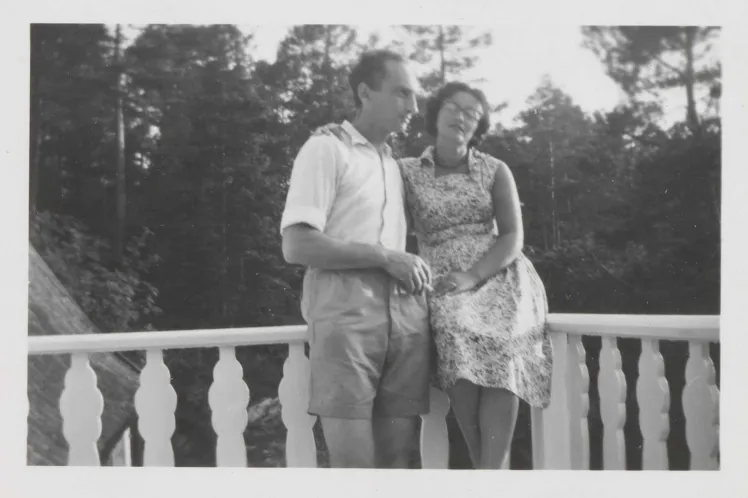
Leonie and Walter Frankenstein on the balcony of a summer house, Elgö, summer 1957; Jewish Museum Berlin, accession 2010/165/16/005, gift of Leonie and Walter Frankenstein
After the death of his wife, Walter continued his work as a historical eyewitness. On June 30, 2014, he was honored with the Order of Merit of the Federal Republic of Germany for his engagement. He keeps the Order in a box together with his Yellow Star (“Judenstern”). For him, the two symbols are inseparably connected:
“The Nazis marked me, Germany gave me a mark of distinction.”
However often I consider Walter Frankenstein’s biography, each time I am impressed by his life accomplishments. I am deeply thankful to have gotten to know Walter personally, and to have met with him regularly to this day. In my opinion, his path and the perspective it has produced are best reflected in the answer that Walter always gives when asked about his Jewish heritage:
“I am the son of a German of the Jewish faith, and I myself am a Swedish citizen and atheist.”
Anna Rosemann, Photographic Collection
Citation recommendation:
Anna Rosemann (2017/18), Memories from the Life of Walter Frankenstein. With Many Photographs from the Walter and Leonie Frankenstein Collection.
URL: www.jmberlin.de/en/node/6137
Contact
Theresia Ziehe
Curator of Photography
T +49 (0)30 259 93 561
F +49 (0)30 259 93 409
t.ziehe@jmberlin.de
Further Reading
If you would like to delve more deeply into the biographies of Walter and Leonie Frankenstein, we recommend the book Nicht mit uns – Das Leben von Walter und Leonie Frankenstein by Klaus Hillenbrand (in German), which was published in 2008 by the Jüdischer Verlag, an imprint of Suhrkamp.

